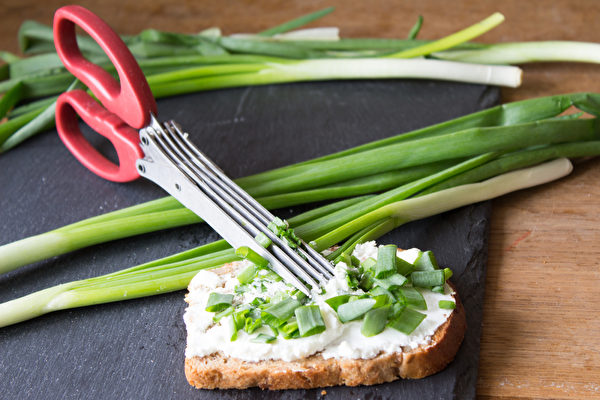High-quality kitchen scissors can replace kitchen knives in handling a variety of ingredients, saving time from washing cutting boards. By choosing multi-functional scissors with features like can-opening and nut-cracking capabilities, one pair of scissors can handle all cooking tasks. Let’s take a look at which ingredients are suitable for kitchen scissors.
Common vegetables and fruits such as broccoli, asparagus, green beans, chili peppers, rehydrated wood ear mushrooms, shiitake mushrooms, tomatoes, bananas, grapes, and more can be directly snipped into a salad bowl or pot with scissors. For leafy vegetables like basil leaves, simply stack the leaves and cut them without needing a knife and cutting board.
Want to quickly cut uniform slices of scallions, cilantro, or seaweed strips? Consider using vegetable shredding scissors. These scissors typically have multiple layers of blades that can produce finely shredded vegetables with just one cut.
Some scissors are designed with small holes in the middle; simply insert fresh herbs and pull one end to easily strip the herb leaves.
Trimming pie crusts, dough, or thick noodles with scissors is very convenient. For flaky pastries, flatbreads, and pizzas, cutting with scissors is quick and neat.
Ingredients like almonds, dried figs, coconut dates, red dates, candied fruits, or rehydrated dried goods are easier and less likely to cause hand injuries when cut with scissors instead of a kitchen knife.
Scissors can handle various meats, from cutting whole racks of ribs or grilled chicken breasts to smaller items like sausages, bacon, or slices of grilled meat into bite-sized pieces. When arranging sausages on a plate, you can also use scissors to cut them into elegant shapes like cutting paper.
Looking to quickly crush canned tomato chunks? Simply open the can, leave the juices inside, and shred the tomatoes with scissors.
Shrimp shells are slippery, and handling shrimp with a kitchen knife may lead to accidental cuts. Using scissors to trim shrimp whiskers, legs, or dealing with whole shrimp can save a lot of effort and reduce the risk of injury.
Handling shrimp with scissors can be easily done on a plate. Firstly, remove the shrimp head, then cut open the back of the shrimp. By gently picking out the shrimp’s digestive tract with the tip of the scissors, it will separate easily.
Flattening a whole chicken for baking ensures even heating. To prepare a flattened chicken, you need to remove the spine. If you are worried about the chicken slipping on the cutting board, using scissors would be helpful. The bones on both sides of the chicken’s spine are fragile, making scissors a suitable tool. After cutting off the spine, press down on the chicken breast to naturally flatten the entire chicken.
When cutting smaller portions of a whole chicken, whether raw or cooked, using scissors instead of a knife can minimize splattering of juices, save the hassle of cleaning cutting boards, and provide convenience in hygiene.
Kitchen scissors not only can cut ingredients but some brands also have thoughtful designs such as opening spiral jar lids or functioning as screwdrivers, showing versatility.
Many kitchen scissors of different brands have serrated grooves in the middle of the handle, specifically designed for cracking nuts.
Kitchen Scissors Tips:
When using kitchen scissors, hygiene should be a priority. It is recommended to have two pairs of scissors – one for handling raw food and another for cooked food. After use, promptly clean and store them in a clean place.
By using kitchen scissors creatively, cooking tasks can be made easier and more efficient, making the kitchen a more enjoyable place to experiment with different recipes and ingredients.

